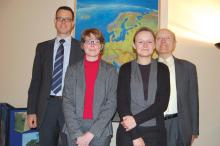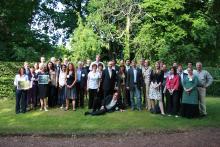
Although it celebrated its 40th anniversary last year, the European Ready Mixed Concrete Organisation is firmly looking to the future. Claire Symes reports
Ready mixed concrete is an essential building material in modern-day construction but until the 1920s concrete was manufactured in batches on demand and on site. Today the industry in Europe alone produces almost 400million cubic metres of material each year off site at hi-tech plants.
Continual innovation in concrete technology is helping to improve the construction properties of the material that is delivered to site and the quality of finished construction. Short shelf life means that ready mixed materials are still essentially a local product but European and international standards means that the issues surrounding the product are much wider.
Representing the industry at European level over the last 40 years is the European Ready Mixed Concrete Organisation -
The Brussels-based operation is headed up by Italian-born general secretary Francesco Biasioli. "ERMCO was set up in 1967 as an unofficial body to provide the ready mixed concrete sector in Europe with a platform to meet and exchange views. Today it is a formalised association that has members in not just Europe but also in Israel, Turkey, Russia, North America, South America and, most recently, India too.
"The way concrete is produced around the Europe is more or less the same in terms of production techniques and equipment, also the sector is facing similar environmental concerns. Therefore it makes a lot of sense for us to be in touch with other partners around the world to exchange knowledge and best practise."
European standards
According to Biasioli, the European concrete standards, in particular those related to design and concrete construction, are widely accepted not just in Europe but in many other countries worldwide. "The European standards are often used for projects in South Africa, India, Brazil and South America - particularly when a European contractor or funding from a European organisation is involved," he said.
The standards used in Europe are more and more frequently being selected for use in non-European countries as the national standards and will form the basis of future international
"Ready mixed concrete has a maximum shelf life of a couple of hours so is not suitable for export in the way that other construction materials are, and is therefore very much a national product. The directive was designed to open borders to easier export of materials, so the two do not fit well together. Also, although we have European standards, there is no single way to produce ready mixed concrete - it is done on a project by project and region by region basis to make the best use of the materials available." While the mix design may vary locally, the new ISO standards will create a common way of testing concrete so the materials' performances can be compared opening the way for more performance-based specifications, but will essentially not change the material delivered to site.
"Having a common approach will give the global industry a common language that will ease work on site," said ERMCO technical consultant John Gibbs. "I was once involved in a project in Africa that was funded by a Japanese bank but that used a mix of the Japanese, North American and European standards. Not only was it confusing in terms of the actual testing and mixing, the combination of metric and imperial units also complicated matters."
Concrete development
While the use of ready mixed concrete in construction is generally taken for granted these days, ERMCO has traced the origins back to the first years of the last century. The first concrete construction is believed to have been undertaken in 10BC but the Romans are commonly credited with the first use of concrete.
However, it was an English engineer, called Deacons, who is thought to have invented the concept of ready mixed concrete. In 1872, he wrote, "..it should be regarded as a big advantage to deliver concrete or mortar ready to fit into the construction area." But it wasn't until the early 1900s that the idea was put into action by a German architect called Heinrich Magens, who worked in Hamburg. He started cooling materials to increase the concrete's shelf life and make it more practical to transport. His gaining of a patent for the idea in 1903 marks the birth of ready mixed concrete.
Magen also discovered the benefits of vibrating concrete, for which he also gained patents and, before the outbreak of World War I, he owned several concrete plants in Hamburg and Berlin. The US was an early adopter of ready mixed concrete technology and the first bespoke ready mixed concrete truck was also built in the US in 1920.
Both Russia and the UK had ready mixed concrete plants in operation in the 1930s and within a few years of the end of World War II, there were plants producing ready mixed concrete throughout Europe.
"Growth in the industry led to establishment of a number of national association for the ready mixed concrete sector in Europe during the 1960s," said Biasioli. "ERMCO was born on 27 October 1967 when 11 national associations with representatives from Austria, Belgium, Finland, France, Germany, Italy, the Netherlands, Spain, Sweden, Switzerland and the UK met in Munich, Germany. The need for a European organisation to represent the industry was debated and ERMCO was officially founded on 1 January 1968."
The founder members were later joined by other European organisations, with membership from Eastern Europe running far in advance of accession to the
The size of the ready mixed concrete industry in Europe has grown dramatically since ERMCO's inception. In 1967, there were 952 companies operating 2593 plants that produced 74million cubic metres of ready mixed concrete and by 1982, there were 2030 firms producing 126million cubic metres. Now there are around 6490 plants producing 440million cubic metres of concrete each year.
ERMCO has been based in the political capital of Europe - Brussels - for the last five years. "Locating in Brussels gives us not just close access to the
Today, the organisation has three permanent staff - Biasioli, John Gibbs as technical consultant and an IT specialist ERMCO has an elected president - currently currently José Ramon Bujanda from Spain, who works for a HYMPSA - Hormigones y Morteros
Preparados - who oversees the board and a number of committees.
"Each of our member associations is represented on the board, which meets four times a year," said Biasioli. "We also have a general assembly each year - this year Poland is hosting the event.
"There are also two standing committees - one looking at strategy and development with six members from the board and external advisors from the major players in the industry and another looking at the environment and technology with a representative from each country.
"We also have a number of working and task groups which are formed on an ad hoc basis to focus on specific issues as they arise. Currently we have two running - one looking at the use of fibres in concrete and the other investigating the need and way forward for environmental product declarations. In the past we have looked at quality control, energy consumption and life cycle assessments.
But ERMCO's vision is more wide ranging than just ready mixed concrete and the organisation gets involved in other construction and materials related issues. "We have a formal arrangement through the European Concrete Platform to work with European association of Cement Manufacturers (
Future focus
While ERMCO is pleased to have reached its 40th year, the organisation's focus is very much on the future. "We have pulled together as an industry in the last 40 years and managed to successfully introduce European standards which work with the industry rather than against," said Biasioli. "But there are still a number of challenges ahead.
"One of the biggest will be the need for the EU to have a common method that can be applied to compare the footprint of different construction methods and industries. At the moment, where systems exist, the approach varies from industry to industry and even business to business. At the point of production concrete components may have a significant environmental impact but over the life cycle of a building, it is minimal and construction clients need a clearer understanding of this to allow them to make effective decisions.
"The other challenge will be the difficulty in gaining access to new aggregate resources - an essential ingredient for ready mixed concrete. Our industry probably accounts for at least 35% of aggregate consumption in Europe, so any issues affecting the supply of aggregates or cement will have a big impact on the ready mixed industry."










